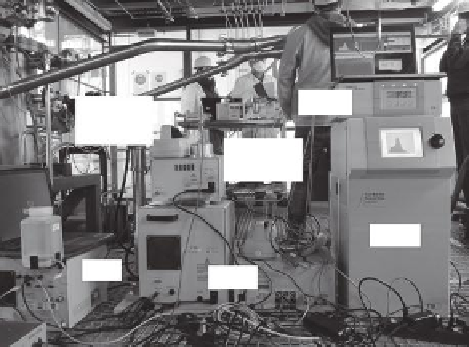Biomedical Engineering Reference
In-Depth Information
composition of the collected particles. Other methods for determining the chemical
composition of the particles in the workplace are by sampling them electrostati-
cally (Dixkens and Fissan 1999) and by impaction (e.g., Marple et al. 1986) onto
flat surfaces which are suitable for analysis by total reflection X-ray fluorescence
(TXRF, John at el. 2001) or in electron microscopes with electron dispersive X-ray
spectroscopy (EDX). The chemical analyses provide clear evidence for whether or
not the nanomaterials produced or handled in the workplace were present in the air-
borne state. If the nanomaterial is a nonubiquitous material in the (workplace) atmo-
sphere, the purely chemical analysis can already provide definitive proof, whereas
in the case of materials that are commonly found in the atmosphere (e.g., silica),
morphological analyses by electron microscopy are required. From the large variety
of information that needs to be assessed in tier 3 measurements, it is obvious that
the set of equipment needed for such measurements is quite extensive. A setup used
during tier measurements at a pilot plant at IUTA (Huelser et al. 2011; Wang et al.
2012) is shown in Figure 11.4.
Similarly to tier 2, the particle background in the workplace can be determined
by using a second set of measuring equipment to measure in a representative back-
ground site or by using the same set of equipment to measure before and after the
considered process. For the extensive measurements in tier 3, it is desirable to have
at least one instrument measuring the total number concentration (e.g., a CPC) in
the background in parallel with high time resolution, because this can help to iden-
tify potential particle sources from outside the work area. If a complete second set
of equipment is used for the background measurements, including size distribution
measurements and particle sampling, more information on possible particle infiltra-
tion from outside can be derived, because it can be shown whether particles of cer-
tain sizes, composition, or morphology had been present in the background.
NSAM
Handheld
CPC
ESP with
charger
FMPS
CPC
SMPS
FIGURE 11.4
Setup of instruments for a tier 3 workplace measurement, including SMPS
and FMPS for measuring submicron particle size distributions, a CPC for measuring particle
number concentration, and an NSAM for LDSA concentration as well as an NAS for particle
sampling for subsequent morphological and chemical analyses.

Search WWH ::

Custom Search